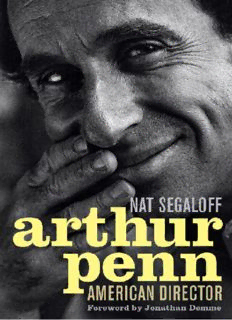
Arthur Penn: American Director (Screen Classics) PDF
Preview Arthur Penn: American Director (Screen Classics)
Arthur Penn Screen Classics Screen Classics is a series of critical biographies, fi lm histories, and analytical studies focusing on neglected fi lmmakers and important screen artists and subjects, from the era of silent cinema to the golden age of Hollywood to the international generation of today. Books in the Screen Classics series are intended for scholars and general readers alike. The contributing authors are established fi gures in their respec- tive fi elds. This series also serves the purpose of advancing scholarship on fi lm personalities and themes with ties to Kentucky. Series Editor Patrick McGilligan Books in the Series Hedy Lamarr: The Most Beautiful Woman in Film Ruth Barton Von Sternberg John Baxter The Marxist and the Movies: A Biography of Paul Jarrico Larry Ceplair Warren Oates: A Wild Life Susan Compo Being Hal Ashby: Life of a Hollywood Rebel Nick Dawson Raoul Walsh: The True Adventures of Hollywood’s Legendary Director Marilyn Ann Moss Some Like It Wilder: The Life and Controversial Films of Billy Wilder Gene D. Phillips Claude Rains: An Actor’s Voice David J. Skal with Jessica Rains Buzz: The Life and Art of Busby Berkeley Jeffrey Spivak Arthur Penn American Director Nat Segaloff Foreword by Jonathan Demme T U P K HE NIVERSITY RESS OF ENTUCKY Copyright © 2011 by Nat Segaloff Foreword © 2011 by Jonathan Demme Published by The University Press of Kentucky scholarly publisher for the Commonwealth, serving Bellarmine University, Berea College, Centre College of Kentucky, Eastern Kentucky University, The Filson Historical Society, Georgetown College, Kentucky Historical Society, Kentucky State University, Morehead State University, Murray State University, Northern Kentucky University, Transylvania University, University of Kentucky, University of Louisville, and Western Kentucky University. All rights reserved. Editorial and Sales Offi ces: The University Press of Kentucky 663 South Limestone Street, Lexington, Kentucky 40508-4008 www.kentuckypress.com 15 14 13 12 11 5 4 3 2 1 All photographs not otherwise credited are courtesy of the Penn family. Because this page cannot legibly accommodate all the copyright notices, the notices appear at the back of the book in a section titled “Credits,” which constitutes an extension of the copyright page. Library of Congress Cataloging-in-Publication Data Segaloff, Nat. Arthur Penn : American director / Nat Segaloff ; foreword by Jonathan Demme. p. cm. — (Screen classics) Includes bibliographical references and index. Includes fi lmography and television credits for directing. ISBN 978-0-8131-2976-1 (alk. paper) ISBN 978-0-8131-2981-5 (ebook) 1. Penn, Arthur, 1922–2010. 2. Motion picture producers and directors— United States—Biography. I. Title. PN1998.3.P4525S46 2011 791.4302’33092—dc22 2010047399 This book is printed on acid-free recycled paper meeting the requirements of the American National Standard for Permanence in Paper for Printed Library Materials. Manufactured in the United States of America. Member of the Association of American University Presses For Arthur, of course Contents Foreword ix Preface xv Acknowledgments xvii Prologue: The Micturating Mogul 1 1 A Boy of Two Cities 5 2 The Theater of War 16 3 The Teachable Moment 24 4 Up at Eight, Off at Nine 30 5 The Edge of Chaos 38 6 Built for Television 49 7 Kid’s Play 60 8 Four for the Seesaw 72 9 Three Miracles 84 10 The King of Broadway 99 11 The Little Play That Could 108 12 Train Wrecks 116 13 Brandeux 128 14 Foggy Mountain Breakthrough 141 15 Golden Boys 162 16 Curtains 173 17 Hippie Sunset 181 18 Little Big Mensch 190 19 A State of Great Disorder 198 20 Sly Foxes 210 21 The Studio 219 22 A Sea of Mud 229 23 Back to Basics 240 Wrap 254 Appendix: Arthur Penn Credits 259 Notes 265 Selected Bibliography 285 Credits 289 Inde x 291 Illustrations follow page 142 Foreword In the middle of Arthur Penn’s magnifi co Four Friends there arrives the now justly immortalized, cosmically American mo- ment where we fi nd ourselves with an American family playing outside with their adopted Vietnamese child, while inside the house the television broadcasts news of the fi rst landing on the moon by U.S. astronauts. It’s fair to call this a quintessentially American moment, brilliantly conceived and crafted by my dear friend and not infrequent mentor, the quintessentially American fi lmmaker, artist, and all-around great guy, Mr. Arthur Penn. (It’s not lost on me that I have already used one particular word— American—way too many times, but when it comes to Penn, this word will just pop up again and again and again because that’s who and what this man is.) The book you are holding is rich in all the vital details and insights pertinent to the fi lmmaker in question, and I have the high honor of providing a few words of introduction here. Because my relationship with Arthur is so deep and long running, I’m introducing him through the prism of my experience of meeting the man fi rst onscreen through his fi lms, and eventually in person as a fellow New Yorker and as a brother in the Directors Guild of America. I fi rst met Arthur in the early 1960s at the Dixie Drive-In Theatre on the outskirts of Miami, Florida, where the usual crew of my movie-obsessed buddies and I, beers in hand and under the stars, watched this western called The Left Handed Gun at our favorite venue. We were all bowled over by this western, way more intimately scaled than we ordinarily cared for; in black and white, which we were not at all partial to; and, what’s more, ix
Description: